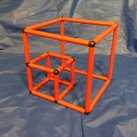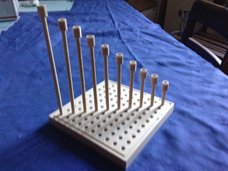Sticks and Ticks
There are three primary measurements the child needs to learn: two of them are space and time.
Measurement of mass, energy and consciousness follow because in order to be talked about and studied they need to exist in a space and at a point in time.
Measuring time is not the same as telling time. It is not just reading the numbers on clocks and relating those numbers to the routines of the day, which is obviously a survival skill. Measuring time is knowing what a clock is and what it does and doesn't do. Measuring space is not just learning to count marks on a ruler, comparing them to some other object and saying how big that object is. Measuring space is about recognizing and using a unit of measure to describe an empty place in two and three dimensions and specifying a point within that space.
Such a point can be specified by an image or by coordinates.
Measuring time and space is knowing how to combine units you've counted in order to locate a discreet entity within a space and a series of events.
Being able to talk about time with children is important for a number of reasons, not the least of which is the nature of memory.
Measuring time is a good example of the classroom technique of putting the child in the circuit, in the shape, in the mechanism. The child can literally be the clock, just by clapping her hands or tapping her nose. She can be the unit of measure with her hands or feet or stride.
In that sense, rhythmic counting is important. Counting, feeling, a beat or sustained pulses of a given length, like 3/4 time, waltz time is placing the child in the repeating wave. In keeping a rhythm the child is riding the basic unit of repetition, the basic reiterating clock as part of a continuous emission. 1-2, 1-2-3, and 1-2-3-4 rhythmic counts simply feel different. In simple and complex combinations, like 5/4 or 6/3, they are the physical experience of simultaneous waves in phase with each other.
There are three primary measurements the child needs to learn: two of them are space and time.
Measurement of mass, energy and consciousness follow because in order to be talked about and studied they need to exist in a space and at a point in time.
Measuring time is not the same as telling time. It is not just reading the numbers on clocks and relating those numbers to the routines of the day, which is obviously a survival skill. Measuring time is knowing what a clock is and what it does and doesn't do. Measuring space is not just learning to count marks on a ruler, comparing them to some other object and saying how big that object is. Measuring space is about recognizing and using a unit of measure to describe an empty place in two and three dimensions and specifying a point within that space.
Such a point can be specified by an image or by coordinates.
Measuring time and space is knowing how to combine units you've counted in order to locate a discreet entity within a space and a series of events.
Being able to talk about time with children is important for a number of reasons, not the least of which is the nature of memory.
Measuring time is a good example of the classroom technique of putting the child in the circuit, in the shape, in the mechanism. The child can literally be the clock, just by clapping her hands or tapping her nose. She can be the unit of measure with her hands or feet or stride.
In that sense, rhythmic counting is important. Counting, feeling, a beat or sustained pulses of a given length, like 3/4 time, waltz time is placing the child in the repeating wave. In keeping a rhythm the child is riding the basic unit of repetition, the basic reiterating clock as part of a continuous emission. 1-2, 1-2-3, and 1-2-3-4 rhythmic counts simply feel different. In simple and complex combinations, like 5/4 or 6/3, they are the physical experience of simultaneous waves in phase with each other.
Linear space is simple. It can be done with floor tiles or a stick, a piece of string, beads on a chain, straws, a pegboard or an actual ruler, with the goal being that everyone understands that they agree about the choice of the tile or the stick or the chain or the ruler. Children agree readily and at first unconsciously. It is the agreement, the conscious recognition and acceptance of the unit of measure that counts and is a learned behavior.
|
Two dimensions means counting in two directions,along two lines, two axes. We call these X and Y. Two dimensions can be taught with a labeled peg board or a labeled tiled floor. The peg is the stick and the stick is the agreed upon unit of measure. A pegboard has a hole at each intersection of X and Y. So the child learns to name each hole, designate it by counting and combing X and Y; which is a case of using two sets of numbers, the numbers on the two axes, to generate a third set, the ordered pairs of the coordinates, by combination in a concrete, physical activity. A labeled floor lets the child actually be in the space and look around from the coordinates' point-of-view. This gives us a game of telling where a particular object is in the classroom using only numbers. It also gives us a 3x3, nine square grid in which the spaces can be given actual names: center, right, left, bottom left, etc, in addition to the intersections being designated by two numbers. Designating, naming a space as well as its corners or intersections are ideas and language the child needs particularly when using images either on paper or on screen in order to program.
|
|

Three dimensions requires pegs of different lengths. A 3 x 3 pegboard needs three pegs: the unit, the two and the three pegs. With these the point 3,3,3, for instance, can be easily designated. A labeled floor takes as many pegs, wooden dowels, as there are squares on a side of the grid. This set of wooden dowels is a set of counting rods like the Montessori number rods.
Three dimensional space can also be put into the child's hands with a wire frame construction kit. Wire frames do something different than building blocks. Frames describe space directly. Blocks are objects in space. Wire frames define the space and present the coordinate points. Visualizing wire frame structures is essential to any illustrated design process.
Wire frame construction kits can be used to make spaces that can be occupied by, for instance, small figures, creatures. And this opens the door to integrating geometric construction and fantasy play.
So, a stick once agreed upon, measures space. It's easy. The tick is trickier.
What exactly is the measurement of time?
This is not the same question as either "what is time?" or "what time is it?"
What, in terms of simple physical action, is time? What is a tick? What is a clock?
A tick, a unit of time, is any regular repeating event that can be counted. The object that exhibits the repeating event is the clock. A tick is one repetition. A clock is not a sensor or a probe or a generator. When we count ticks we are not measuring a dimension or a kind of material or an energy or anything that exists beyond the event being used as the agreed upon tick. Time may well be all those things but when we count time all we are doing is counting a regular, repeating physical event. That's it.
We can then compare ticks counted to any other event or series of events and say how many ticks the event or series of events takes. That is the primary meaning of time and of measuring time.
One of the oldest clocks we can show the child, culturally, is a water clock, a bowl with a hole filled with water. The hole physically regulates the dripping of the water and marks on the inside of the bowl record the progress of the loss of water. Another easy example is an egg timer; sand falling at a consistent rate. The sand clock has the additional advantage of presenting the idea that discreet objects can behave very much like liquids, a consideration that belongs to Motion which is one of the eight forms of Energy. There are also sundials, pendulums, mechanical, digital and atomic clocks. They are all regular repeating events. Regular enough that we can agree to use them on cultural and scientific levels.
The child can provide the regular repeating event, be the clock literally. So can a group sitting in circle. Clap hands steadily and count. Not only is this idea and skill useful mathematically and scientifically it is essential to the child as a musician. It is the ability to feel, maintain and enjoy keeping a beat and doing so with great enough precision to do it in concert with other musicians.
Have one child do something, like walk ten floor tiles, while someone else claps and counts. Practice together so that it takes ten claps to walk ten tiles. Combine the two, one walk is ten tiles and takes ten claps to do; one tile for each clap. This is our first ratio. Sticks compared to ticks produces a third number answering the question, how fast? In a simple, concrete, physical way this is the child's first three part equation. How fast? is sticks compared to ticks.
speed = distance/time

